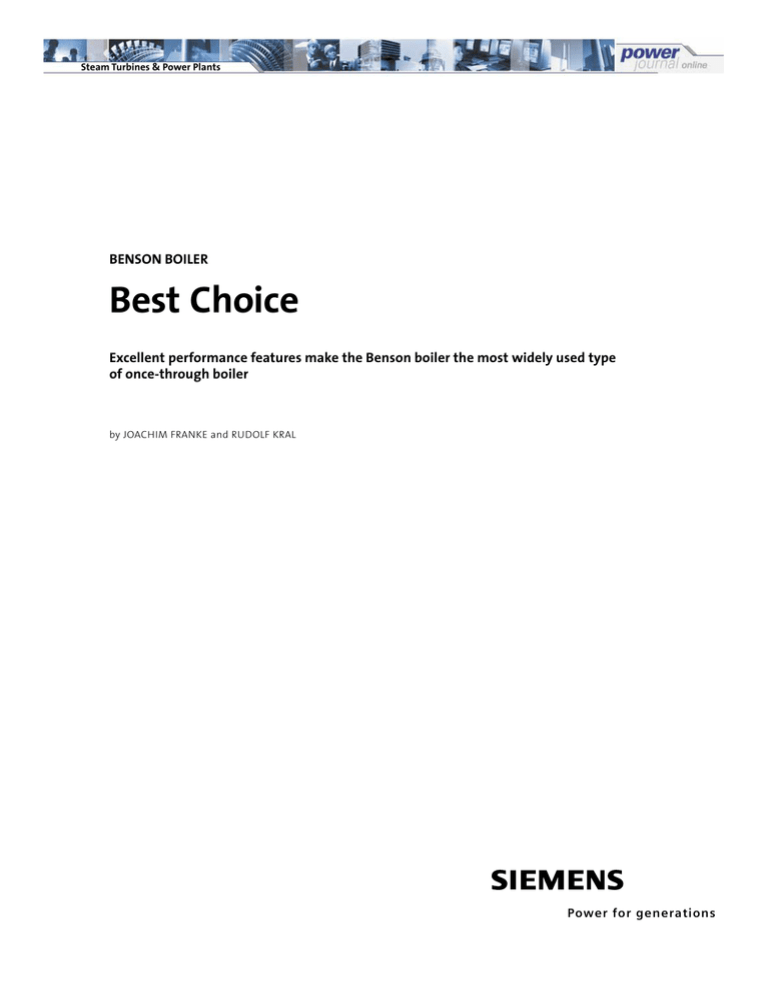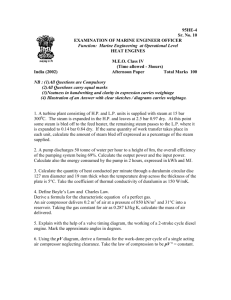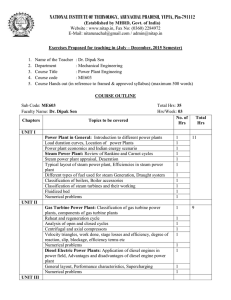Best Choice
advertisement

Steam Turbines & Power Plants BENSON BOILER Best Choice Excellent performance features make the Benson boiler the most widely used type of once-through boiler by JOACHIM FRANKE and RUDOLF KRAL Power for generations Steam Turbines & Power Plants BENSON BOILER Best Choice High capacity and excellent operating characteristics are main features of the Benson boiler, making it the most widely used type of once-through boiler by Dr. JOACHIM FRANKE, expert on Benson boiler technology, in charge of licensing and continued development of this steam generator type, Siemens Power Generation and RUDOLF KRAL, expert for steam generator technology in the engineering sector and technical consultant to Benson licensees, Siemens Power Generation With a total of more than 1,000 units having established a proven track record over many years in the power generation industry, the Benson boiler is the most commonly used type of once-through boiler. It operates at power levels of up to 1300 MW, steam pressures of up to 350 bar and steam temperatures of up to more than 600°C. About a quarter of the units operate at supercritical pressures. Given its performance features and operating characteristics, it is no surprise that Benson technology has been successful. Up to now, its use has been most widespread in central Europe, Japan and South Africa, but numerous countries are showing growing interest in this technology. Convincing Technology Steam generators using the Benson design—one pass through the evaporator section and variable endpoints of evaporation—incorporate features which are critical to economic success in today’s competitive power markets. These features include • a highly efficient steam/water cycle as a result of supercritical pressures and high steam temperatures, • ability to undergo rapid load changes due to a design that allows unconstrained thermal expansion and a variable-pressure operating mode in the part-load range, 1 of 4 Siemens power journal online, October 2001 • insensitivity of steam output and superheated steam temperature to fluctuating fuel properties. Benson boilers are equally well suited for both subcritical and supercritical pressures; steam pressure is limited almost solely by the properties of the materials used. Due to a design that allows unconstrained thermal expansion— no drum, low storage masses—Benson boilers are ideal for use in the mid- and peakload operating ranges. The variable-pressure operating mode prevents stressing of the steam turbine materials due to changes in temperature. Environmental protection also benefits due to the low specific exhaust gas emissions achieved as the result of high efficiencies, as well as through the use of low-NOx combustion methods and proven, powerful flue-gas cleaning processes. Performance Features Highest Steam Pressures and Temperatures Supercritical steam pressures were already being used in central Europe in the 1960s, while superheated steam temperatures remained in the 540°C/560°C range until the mid-1990s. The 550-MW Unit 5 Furnace of a 930-MW lignitefired unit under construction Steam Turbines & Power Plants pact combustion chamber which, along with the two separate flue-gas paths, provides advantages in terms of installation options. Moreover, the separate cross sections of the second pass and combustion chamber make it possible to optimize the configuration of the convective heat-exchange surfaces, and thus also their size. A typical example of the double-pass design is the hard-coal-fired steam generator at the Hemweg power plant in The Netherlands. at the Staudinger power plant in Germany is representative of this level of technology with supercritical steam pressure at full load and outlet temperatures of 545°C (with HP superheater) or 562°C (with reheater). Other features of this unit include variable-pressure operation and a net efficiency of 43%. Nordjyllandsvaerket plant 410 MWel; imported coal 270 kg/s main steam 310 bar, 582°C/580°C Denmark Staudinger plant, Unit 5 550 MWel; hard-coal-fired 417 kg/s main steam 285 bar, 545°C/562°C Germany At these steam temperatures, wellproven and cost-effective ferritic materials are adequate for the end stages of the high-pressure and reheater heat-exchange surfaces. At higher temperatures, more advanced ferritic chromium steels are required for the thick-walled components, while austenitic materials are required for the final superheater heat-exchange surfaces. The value of such materials has been proven over many years of service in the Benson boilers of the Danish Nordjyllandsvaerket and Skaerbekvaerket power plants, for example, at steam temperatures of 580°C. Operating experience at 600°C has to date been gained only from boilers in Japan. 2 of 4 Siemens power journal online, October 2001 Today, state-of-the-art developments in materials permit steam temperatures of up to 600°C (with HP superheater) or 620°C (with reheater). Variable Designs Depending on plant-specific requirements, Benson boilers are of single- or double-pass design. The single-pass steam generator has clear operational advantages when coals with a high ash content or severely corrosive ash are used, since there is no reversal of the flue gases and thus no additional ash concentration in the vicinity of the heat-exchange surfaces. All modern European lignite-fired steam generators are therefore of the single-pass design. Other advantages of this type of steam generator include single-wall design with its favorable unconstrained thermal expansion characteristic. The double-pass steam generator is characterized by its low height and a com- Hemweg plant 660 MWel; imported coal 530 kg/s main steam 261 bar, 540°C/540°C The Netherlands Flexible Use of Fuel Since Benson boilers can be designed to accommodate a wide range of coal types, plant operators are able to use the lowestpriced coal available. The combustion chamber size and shape, the firing system and the thermodynamics of the boiler are then matched to the combustion properties of the range of fuels in question. Due to the variable endpoint of evaporation, the combustion chamber can be dimen- Steam Turbines & Power Plants sioned solely in accordance with the corresponding firing characteristics. One advantage of Benson boiler operation is that the required steam output and main steam temperature are always achieved, even if the properties of the coal are highly variable. A prime example is the Benson boiler at the Staudinger power plant, which is capable of firing a wide range of coals—from highly volatile hard coals up to and including anthracite—in its amply dimensioned combustion chambers with opposed firing. Benson boilers can be outfitted with various types of firing systems. In addition to conventional pulverized-coal firing, systems with liquid-ash separation, with circulating fluidized beds, for example, as well as systems for firing biomass can be used. Examples are the boiler with liquid-ash removal at the 660-MW Ibbenbüren power plant that has two slag-tap furnaces with a common gas radiation chamber, as well as the boiler with circulating fluidized-bed firing at the 100-MW Ibbenbüren plant 750 MWel; anthracite 600 kg/s main steam 220 bar, 530°C/530°C Germany 3 of 4 Siemens power journal online, October 2001 Moabit power plant. At the Moabit plant the fluidized-bed coolers, in addition to the walls of the combustion chambers and the ash cyclone, are also utilized as evaporators. In Demand Worldwide In Germany, hard-coal-fired Benson boilers in the 800-MW to 1000-MW output range have been operating successfully and at high availability levels for several years. The two 930-MW units at the Lippendorf power plant achieved this same output using lignite, a much more problematic fuel. A steam generator of the same capacity is also installed at the Boxdorf power plant. These Benson boilers are among the largest in the world, with a combustion chamber cross section of 24×24 m and a boiler height of more than 160 m. As early as the 1950s and 1960s, a number of power plants built in the U.S. were operating at supercritical steam pressure. Since the boilers used at that time were Lippendorf plant 930 MWel; lignite 672 kg/s main steam 285 bar, 554°C/583°C Germany only marginally suitable for variable-pressure operation, American manufacturers today are also setting their sights on modern Benson boiler technology. Although the American market has seen almost no new plants built since the mid-1980s, this technology is being used successfully for export. In Japan, the development trend in recent years has been toward very high steam pressures and temperatures. Since 1980, once-through boilers have been essentially the only type used in power plants in Japan, about half of them Benson boilers operating at supercritical pressures. Steam generators operating superheated steam temperatures of 600°C and with capacities of up to 1000 MW have already been in operation for many years. In Japan, traditional preference has been given to the double-pass design, such as that used at the Hekinan power plant. Due to the low ash content of the coals used, the operational advantages of the single-pass design with regard to wear and tear of the heat-exchange surfaces would not be significant. Hekinan plant 700 MWel; imported coal 639 kg/s main steam 255 bar, 543°C/569°C Japan Steam Turbines & Power Plants At the beginning of the 1970s, South Africa recognized the advantages of Benson boiler technology. Since that time, twenty-four large units with ratings between 500 and 730 MW have been outfitted with Benson boilers. The single-pass design is preferred due to the high ash content of the coal in that region. In China, both drum-type and oncethrough boilers are used for unit ratings of up to 300 MW. In the future, plants in the 700/900-MW class will be designed only for supercritical steam pressures and temperatures. A supercritical, hard-coal-fired, double-pass Benson boiler is currently being designed for the 700-MW Taishan plant. Leading manufacturers around the world are marketing the advantages of Benson boiler technology through licensing agreements. At Siemens, activities related to the Benson boiler include boiler design, thermodynamic and hydraulic design, startup systems, control concepts and operating principles. Licensees for Benson Boiler Manufacture Austria Austrian Energy & Environment Denmark FLS miljØ (Burmeister & Wain) England Mitsui Babcock Energy Germany Babcock Borsig Power (Deutsche Babcock, Steinmüller) India BHEL Italy Ansaldo Japan Babcock-Hitachi Kawasaki Heavy Industries USA Babcock & Wilcox Foster Wheeler Outlook on Further Development Worldwide use of the Benson boiler is in no small measure the result of ongoing efforts at Siemens Power Generation to further develop this technology. The expanded knowledge base obtained through detailed studies, particularly of the heat transfer mechanisms within the combustion chamber tubes, has made an important contribution to this effort. New evaporator designs with vertical tubing will continue to improve operating behavior and make manufacture of the boilers more cost-effective. An initial reference boiler that employs this new evap- Hekinan 4 of 4 Hemweg Siemens power journal online, October 2001 orator design is already under development for refurbishment of a coal-fired 300-MW steam generator in China. The Benson boiler is also ideally suited for even higher steam pressures and temperatures (designs for temperatures of 700°C with plant efficiencies of more than 50% are being studied as part of the EU‘s THERMIE project) due to its variable, freely expandable construction and high operating flexibility. ■ Nordjyllandsvaerket Staudinger Ibbenbüren Lippendorf






